When it comes to mushrooms, there are a wide variety of shapes, sizes, and colors. But, there is one type of mushroom that is sure to stand out and that’s the brain mushroom.
What kind of mushroom looks like a brain? These brain-like mushrooms include Eastern cauliflower mushrooms, gyromitra esculenta, Hen of the woods, and the giant puffball.
These wild mushrooms get their name from their appearance which is strikingly similar to a human brain. They can be found in the US and other parts of the globe. Some are edible while others are not.
Although they may not be the most appetizing looking mushroom, their unique appearance is sure to catch your attention. Below, we’ll list different mushrooms that look like brains and their images to help you identify them when you go mushroom hunting.
List of Brain Mushrooms
It is important to be cautious when identifying and consuming wild mushrooms, as some species can be poisonous. If you are unsure whether a mushroom is safe to eat, it is best to err on the side of caution and not consume it.
1. Eastern cauliflower mushroom
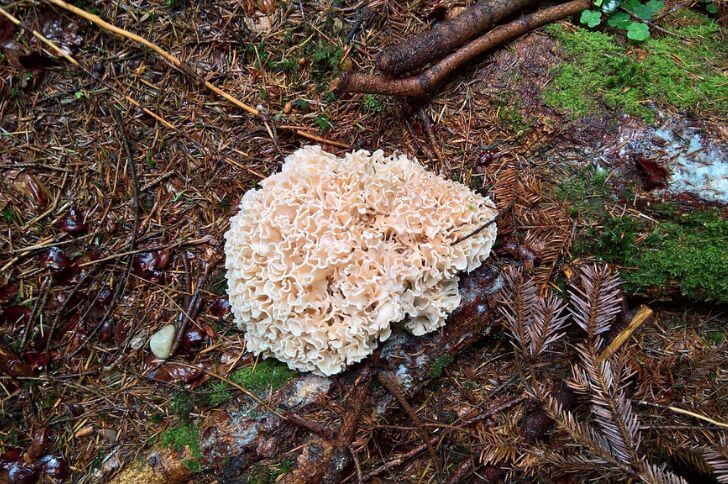
Large and wavy, Eastern cauliflower mushrooms are inedible when raw. They must be cooked before consumption. When cooked properly, this type of mushroom can be a delicious addition to any meal. The eastern cauliflower mushroom gets its name from its appearance, as it resembles a small head of cauliflower.
It mostly grows at the base of oak stumps. You’ll notice each mushroom grows singly. These brain-like mushrooms have a yellowish-white rosette, are wavy and stalkless. They are closely related to the wood cauliflower mushrooms and resemble the hen of the woods.
A mature cauliflower mushroom can measure up to 12 inches and has a height of 6-10 inches. When can you find these brain mushrooms? During wet summers. Also, they tend to reappear around the same decaying stumps every year.
This type of mushroom is found in eastern North America and can be frozen or dried.
2. Hen of the Woods
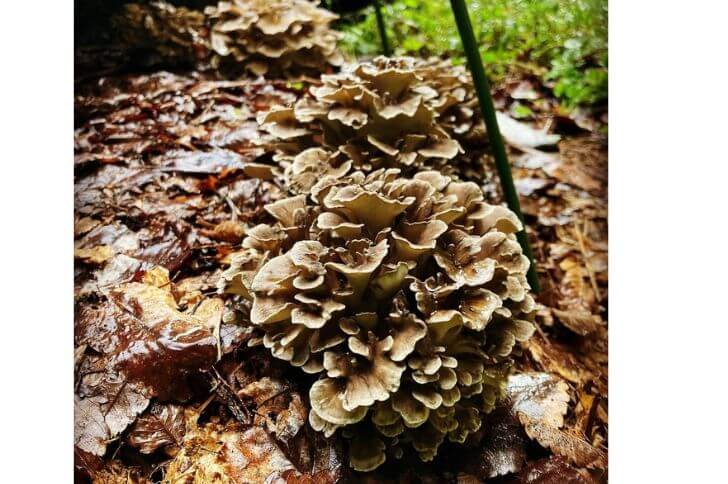
Mushrooms are a type of fungi that have many different species. One popular edible mushroom is the hen of the woods. The scientific name for this mushroom is Grifola frondosa.
This mushroom grows in clusters at the base of trees, and has a large, fan-like shape. The top side of the mushroom is covered in small scales, while the bottom side has pores that release spores. The inside of the mushroom is white or cream-colored.
Hen of the woods mushrooms are often used in recipes that call for other mushrooms, such as shiitake or portobello mushrooms.
They can be grilled, roasted, or sauteed. When cooked, they have a slightly chewy texture and their flavor is nutty and earthy.
Where can you find these wild mushrooms? Apart from local groceries, you can forage for them. Mushroom hunters often hunt for them during fall. They are mostly common in the Northeastern states of the US. They favor damp conditions, the fruit body growing up to 40 inches.
3. Brain Puffball
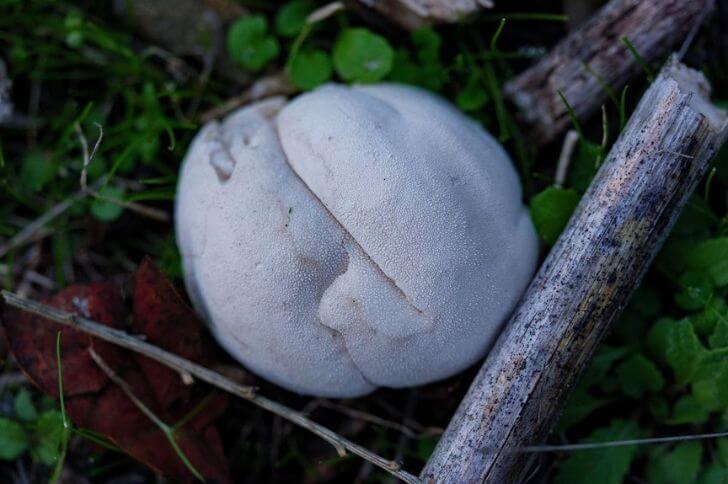
Preferring wet areas in hardwood forests and open woodlands, the brain puffball is an edible fungi that looks like brains. Scientific name for this brain-like mushroom is Calvatia gigantea.
Brain puffballs are white or pale gray in color and have a round shape. The fruiting body can range in size from 3.1-7.9 inches in diameter and up to 7 inches tall.
Why is it called a brain puffball mushroom? Young mushrooms from this species are not easy to recognize. They have a pear-shaped appearance and are soft, just like other species in their family.
But as they mature you’ll notice the smooth surface will start folding and olive-brown spores start forming, giving it a brain-like look.
Brain puffballs are edible, but they must be cooked before eating. When they are young and fresh, brain puffballs can be used in soups and stews. Avoid older brain puffballs.
Related Read: Beautiful mushrooms
4. Snow False Morel (Gyromitra Gigas)
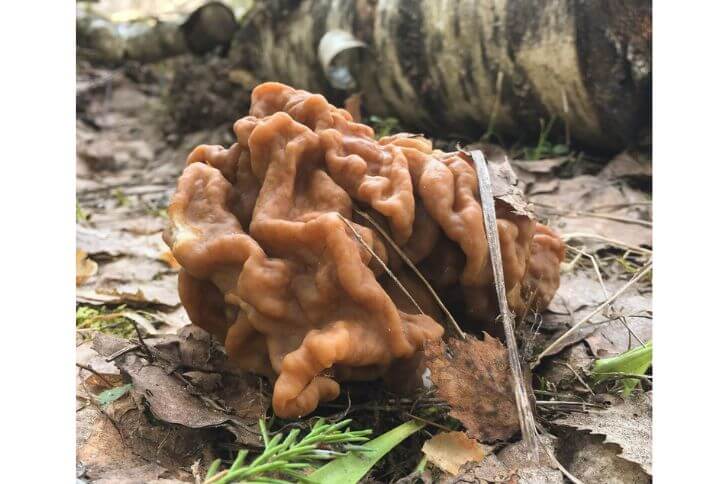
Snow false morel or the gyromitra gigas is a type of false morel mushroom that can be found in the springtime and early summer. This edible mushroom has a 1.5-4 inch dark brown to tan, folded cap that looks like a brain.
It has a hollow stem that grows up to 2.5 inches tall. . Snow false morels grow best in moist, shady areas with plenty of organic matter. Its flesh is whitish. They can be found growing on logs, stumps, and dead leaves.
When it comes to preparing snow false morels for consumption, it is important to cook them thoroughly. When cooked properly, snow false morels have a nutty flavor and a firm texture.
Snow false morel mushrooms are also known as calf brains, bull nose, or giant false morels.
Related Read: Learn about the edible mushrooms of Colorado
5. Leafy Brain Fungus
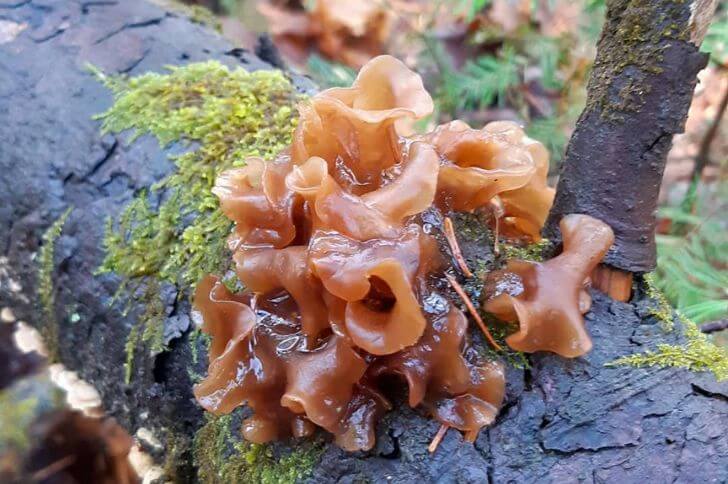
Leafy brain fungus or brown witch butter or the jelly leaf, is a type of parasitic fungi that looks like a brain. It grows on dead conifer trees or branches and prefers temperate regions of the North.
The leafy brain mushroom has a brown fruiting body that can measure up to two inches. Like other mushrooms on this list, their cap has folds that give it a brain-like look. Leafy brain fungus are edible but flavorless.
6. Golden Jelly Fungus
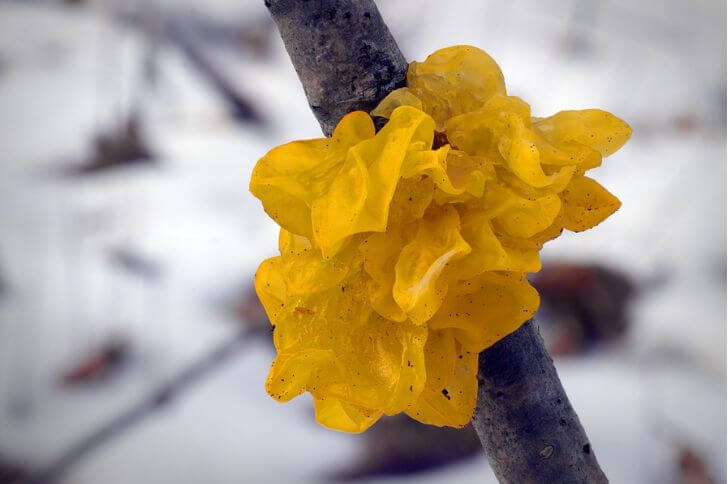
Golden jelly fungus, also known as Tremella mesenterica, is a yellowish-white gelatinous fungus that grows on dead hardwood trees. The fungus is often found in woodlands in late summer and autumn. They prefer wet conditions.
This brain mushroom is edible and has a slightly sweet taste. It can be used in jams, jellies, and desserts. The fungus is high in vitamin C and iron. It also has several other minerals.
Golden jelly fungus is considered a delicacy in many parts of the world. It is sometimes called witch’s butter, yellow trembler, or yellow brain.
Non-Edible Mushrooms that Look like Brains
7. False Morel Mushroom
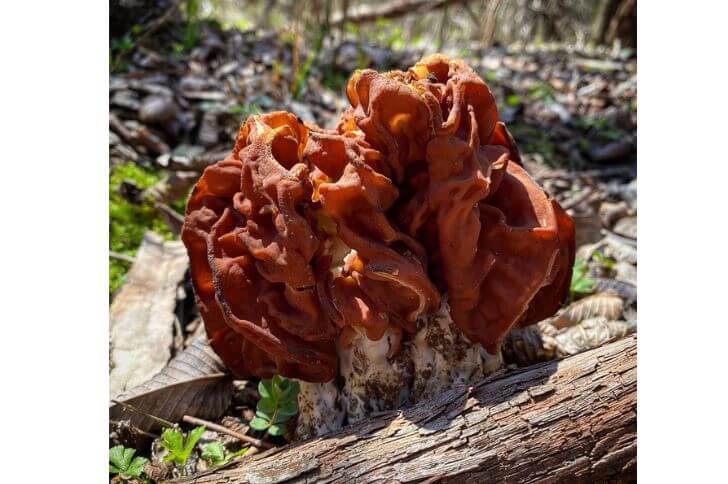
False morel mushrooms are a type of fungi that can be found in many different parts of the United States and the world. They get their name from their resemblance to true morel mushrooms, which are edible. However, these brain-like mushrooms are not edible.
There are two common types of false morels; the Gyromitra caroliniana and the Gyromitra esculenta
There are a few different ways to tell the difference between false and true morels. First, false morels tend to be much larger than true morels. Second, false morels have a “non-hollow” stem, while true morels have a hollow stem.
Also, false morels have a lobed cap while true morels have ridges and pits. Finally, the cap of a false morel is attached to the stem at only one point, while the cap of a true morel is attached to the stem at several points.
If you’re looking for edible mushrooms, it’s best to avoid false morels altogether. These mushrooms are also known as elephant ears mushrooms.
8. Carolina False Morel
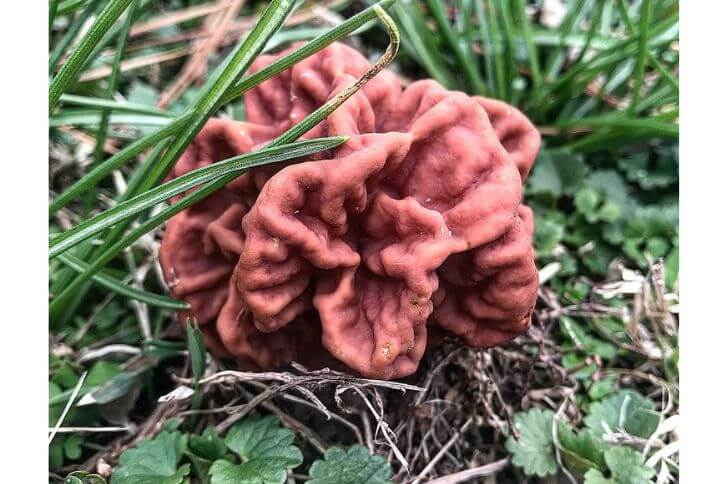
Gyromitra caroliniana is a species of parasitic fungus that can be found growing on the bark of trees in the hardwood forests in the Southeastern US. This mushroom that looks like a brain can grow to massive sizes.
On average a mature fungus is about 2.4-5 inches in diameter, 5.8-7.9 tall while its stipe can grow up to 4.3 inches thick. It has a dark brown cap that has dense folds, giving it the brain look. It is choice edible.
FAQs
Where do brain mushrooms grow?
Both edible and inedible fungi grow mostly in hardwood forest. They favor dead oak branches, trees.
What are elephant ear mushrooms?
Elephant ear mushrooms are a type of mushroom that are commonly found in northern climates. The caps of these mushrooms are shaped like ears and they have a spongy texture. These mushrooms are choice edible.
Are brain mushrooms good for eating?
There are different types of mushrooms that look like brains. Edible brain mushrooms include the Eastern cauliflower, brain puffball and hen of the woods.
What kind of mushroom looks like a brain?
Some mushrooms have a shape that is similar to a human brain. Some of the most common types are mushroom gyromitra esculenta, Carolina false morel, Hen of the woods, Eastern cauliflower mushroom, and leafy brain fungus.
Sources:
Hi There,
My name is Jenny. I’m the Chief Editor at Try Green Recipes and besides making yummy and healthy foods for my kids, grandkids, and friends. I’m new to the blogging world but I believe what I have to share is unique and will bring joy to your home. If you are adventurous and want try something tasty, let’s get started.

